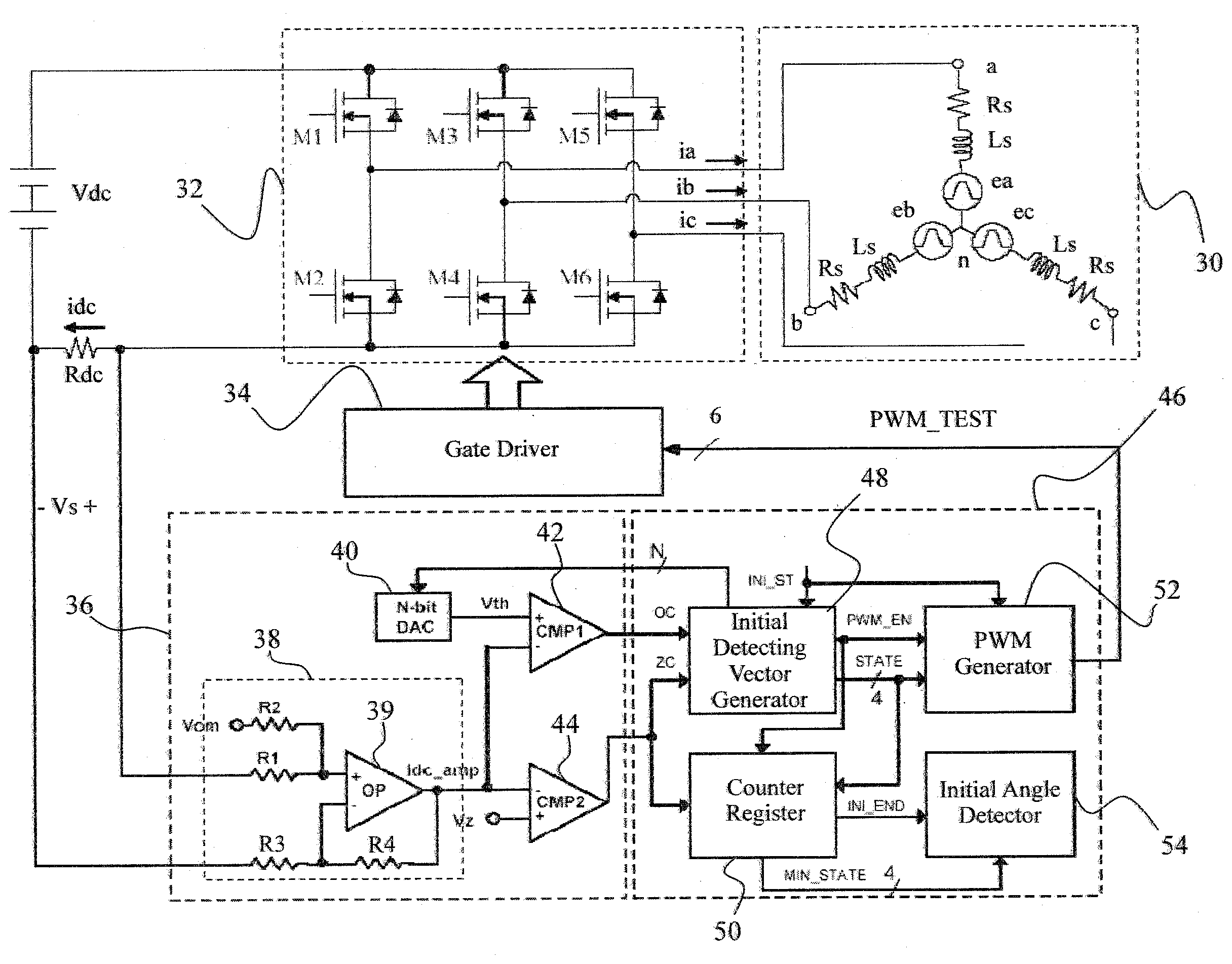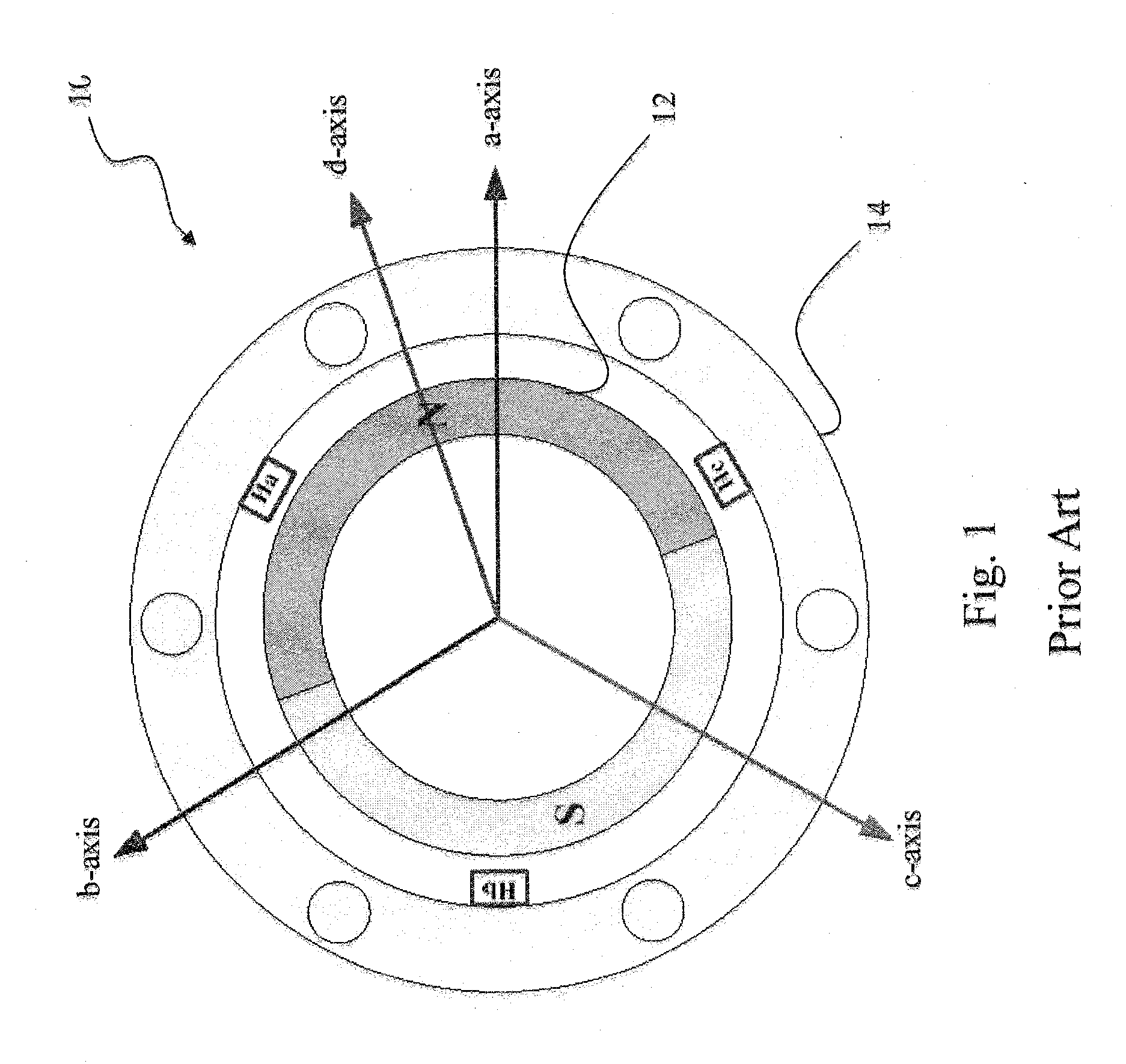Initial rotor position detection for permanent magnet synchronous motors
a synchronous motor and initial rotor technology, applied in the direction of motor/generator/converter stopper, electronic commutator, dynamo-electric converter control, etc., can solve the problem of increasing the machine size and cost of the motor drive, reducing the reliability of the system, and research suffer the same difficulty in detecting the rotor position at standstill. problems, to achieve the effect of smooth startup performance, fast detecting process, and high sensitivity to noise issues
- Summary
- Abstract
- Description
- Claims
- Application Information
AI Technical Summary
Benefits of technology
Problems solved by technology
Method used
Image
Examples
first embodiment
[0039]FIG. 6 is a circuit diagram of a first embodiment according to the present invention, in which a gate driver 34 switches power switches M1-M6 in a PWM inverter 32 according to a signal PWM_TEST provided by an internal digital initial angle detector 46 so as to apply different voltage vectors to a PMSM 30, a shunt resistor Rdc is coupled to the PMSM 30 for establishing a DC-link current idc related to a motor current of the PMSM 30 to be detected to generate a sensing signal Vs, an internal analog current processing circuit 36 generates an over-current signal OC and a zero-current signal ZC according to the sensing signal Vs, and the internal digital initial angle detector 46 generates the signal PWM_TEST according to the over-current signal OC and the zero-current signal ZC.
[0040]FIG. 7 is a waveform diagram of the circuit shown in FIG. 6. When the PMSM 30 is started from standstill, a starting signal INI_ST, as shown by the waveform 60, is provided to enable an initial detect...
second embodiment
[0044]FIG. 9 is a circuit diagram of a second embodiment according to the present invention. In addition to the PMSM 30, the inverter 32, the gate driver 34, the shunt resistor Rdc, and the internal analog current processing circuit 36 the same as those of FIG. 6, an internal digital initial angle detector 80 has the initial detecting vector generator 48 to provide the signal PWM_EN and the state signal STATE according to the over-current signal OC and the zero-current signal ZC. The PWM generator 52 in the internal digital initial angle detector 80 generates the signal PWM_TEST according to the signals PWM_EN and STATE to switch the voltage vector applied to the PMSM 30. A counter register 82 in the internal digital initial angle detector 80 detects the zero-current signal ZC to count the fall time of the motor current in the PMSM 30 under each of the voltage vectors. After obtaining the fall time corresponding to the presently applied voltage vector, the fall time is compared with...
fourth embodiment
[0046]FIG. 11 is a circuit diagram of a fourth embodiment according to the present invention. In addition to the PMSM 30, the inverter 32, the gate driver 34, and the shunt resistor Rdc the same as those of FIG. 6, this embodiment includes an internal analog current processing circuit 100 and an internal digital initial angle detector 102. The internal analog current processing circuit 100 includes the double-ended amplifier circuit 38 for amplifying the sensing signal Vs detected from the shunt resistor Rdc and adding the offset voltage Vcm to the sensing signal Vs so as to generate the amplified signal Idc_amp, the comparator 42 for comparing the voltage Vth with the amplified signal Idc_amp so as to generate the over-current signal OC, and the comparator 44 for comparing the amplified signal Idc_amp with the voltage Vz so as to generate the zero-current signal ZC. The voltage Vth is a constant in this embodiment. The initial detecting vector generator 48 in the internal digital i...
PUM
 Login to View More
Login to View More Abstract
Description
Claims
Application Information
 Login to View More
Login to View More - R&D
- Intellectual Property
- Life Sciences
- Materials
- Tech Scout
- Unparalleled Data Quality
- Higher Quality Content
- 60% Fewer Hallucinations
Browse by: Latest US Patents, China's latest patents, Technical Efficacy Thesaurus, Application Domain, Technology Topic, Popular Technical Reports.
© 2025 PatSnap. All rights reserved.Legal|Privacy policy|Modern Slavery Act Transparency Statement|Sitemap|About US| Contact US: help@patsnap.com



